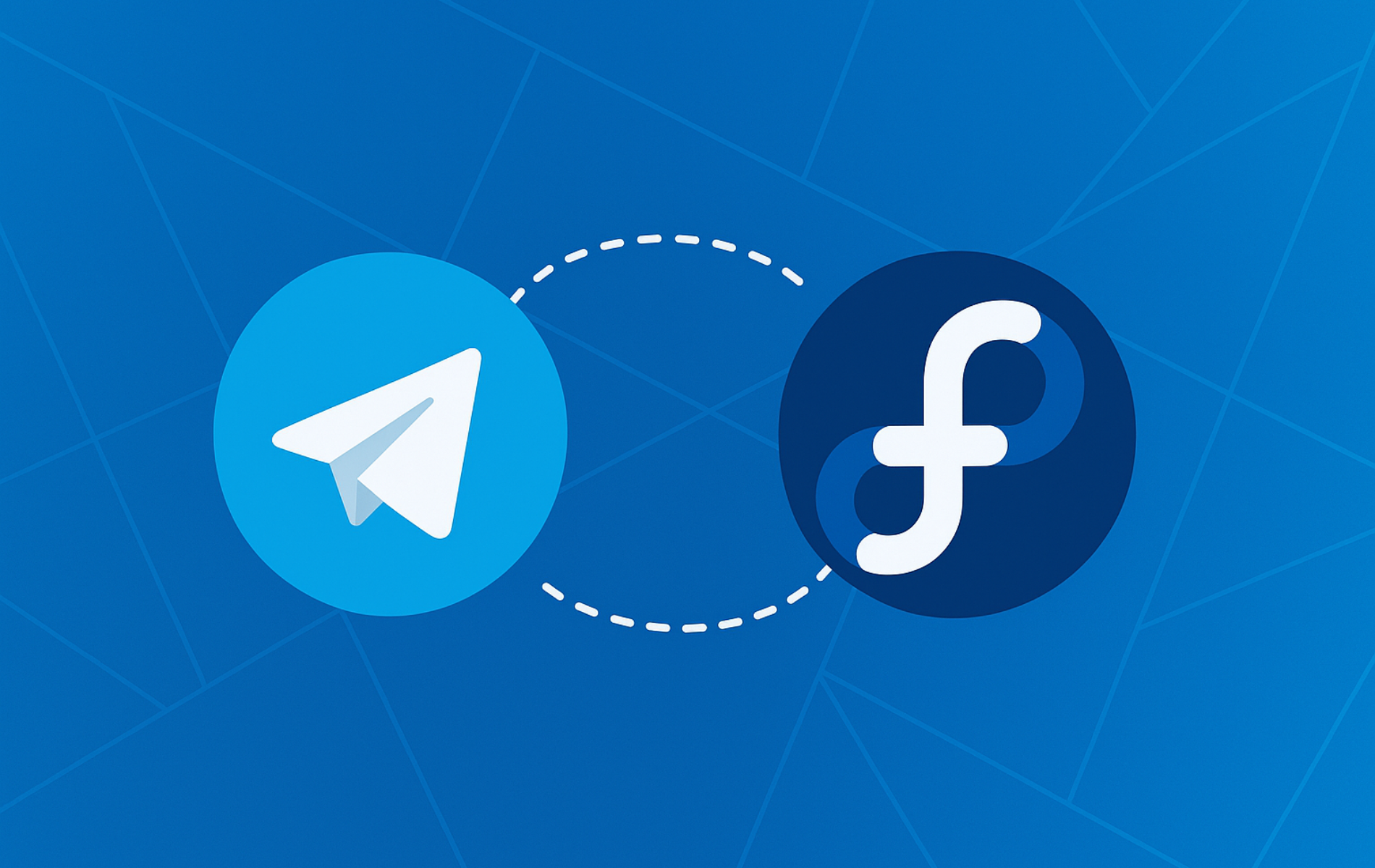Telegram is a fast, secure messaging app that handles encrypted chats, large file transfers, and cloud sync without heavy setup. It supports groups, channels, bots, and custom themes, making it useful for team coordination, community broadcasts, and personal conversations across desktop, mobile, and web.
This guide explains how to install Telegram Desktop on Fedora with two options: RPM Fusion for native DNF integration and Flatpak from Flathub for sandboxed isolation. You will enable the necessary repositories, install the package, launch Telegram, and handle updates or removal.
Choose Your Telegram Installation Method
Fedora supports two installation paths for Telegram, each with trade-offs in system integration, update management, and application isolation. The method you choose determines how updates are delivered and how isolated the application runs.
| Method | Integration | Best For | Trade-offs |
|---|---|---|---|
| RPM Fusion | Native DNF package management, system-level installation | Users wanting seamless Fedora integration, standard update workflows, minimal overhead | Shares system libraries, less isolation than Flatpak |
| Flatpak | Sandboxed container with explicit permissions | Users prioritizing application isolation, security boundaries, or running multiple versions | Larger disk usage, additional Flatpak layer, separate update mechanism |
RPM Fusion delivers Telegram through Fedora’s native packaging system, so updates arrive alongside kernel patches and system libraries without a separate workflow. Flatpak isolates Telegram in a containerized environment with controlled filesystem access and explicit permission prompts, adding a security layer that keeps the app contained.
RPM Fusion suits most Fedora users because it uses the standard DNF update process with minimal overhead. Choose Flatpak when you want tighter sandboxing or need to keep separate versions from other applications.
Method 1: Install Telegram via RPM Fusion
Before installing Telegram, update your system packages to prevent conflicts and ensure compatibility with current repository metadata. Run the following command to refresh package indexes and upgrade installed software:
sudo dnf upgrade --refreshImport RPM Fusion Repositories
Next, enable the RPM Fusion free and non-free repositories that host Telegram and thousands of other applications unavailable in Fedora’s default repositories. Execute these commands to add both repository channels:
sudo dnf install https://download1.rpmfusion.org/free/fedora/rpmfusion-free-release-$(rpm -E %fedora).noarch.rpmsudo dnf install https://download1.rpmfusion.org/nonfree/fedora/rpmfusion-nonfree-release-$(rpm -E %fedora).noarch.rpmInstall Telegram via DNF Command
After enabling RPM Fusion, install Telegram Desktop through DNF. The package manager resolves dependencies and configures desktop integration:
sudo dnf install telegram-desktopMethod 2: Install Telegram via Flatpak and Flathub
Flatpak provides containerized isolation with controlled permissions and filesystem access. Fedora ships with Flatpak pre-installed, but you need to configure the Flathub repository to access third-party applications like Telegram. This step is quick and unlocks many sandboxed apps.
Enable Flathub for Telegram Installation
First, enable the Flathub repository to access Flatpak applications. Fedora includes Flatpak but requires explicit Flathub configuration; run the command below to add Flathub:
sudo flatpak remote-add --if-not-exists flathub https://flathub.org/repo/flathub.flatpakrepoInstall Telegram via Flatpak Command
After enabling Flathub, install Telegram at the system level so all users can access the application. Use sudo to install system-wide; omit sudo to install only for the current user.
sudo flatpak install flathub org.telegram.desktopTelegram Flatpak Troubleshooting
If you encounter the error below when installing Flatpak applications, it indicates the Flathub remote is disabled even though it appears configured. For example, you may see this summary-fetch error when a previous configuration step failed.
error: Unable to load summary from remote flathub: Can't fetch summary from disabled remote 'flathub'
To fix this, explicitly enable the Flathub remote with the modify command:
sudo flatpak remote-modify --enable flathubLaunch Telegram
Once installation completes, launch Telegram through the desktop application menu or command line. Most users will prefer the graphical interface, while terminal commands help with scripts, remote sessions, or troubleshooting startup issues.
CLI Commands to Launch Telegram
For RPM Fusion installations, start Telegram from the CLI with the binary name:
telegram-desktopFor Flatpak installations, use the full application identifier with the Flatpak run command:
flatpak run org.telegram.desktopGUI Method to Launch Telegram
For everyday use, open Telegram through your desktop environment’s application menu using the following path:
Activities > Show Applications > Telegram.


Manage Telegram Updates and Removal
Beyond installation and launching, you may need to update Telegram or remove it entirely. Use the commands that match your installation method.
Update Telegram
RPM Fusion installations receive updates through standard system update workflows. Run the following command to update all system packages including Telegram:
sudo dnf upgradeFlatpak installations require separate update commands. Update all Flatpak applications system-wide with:
sudo flatpak updateTo update only Telegram, specify the application identifier:
sudo flatpak update org.telegram.desktopRemove Telegram
If you want to uninstall Telegram, use the removal command that matches your installation method. For RPM Fusion installations:
sudo dnf remove telegram-desktopOptionally, disable the RPM Fusion repositories if you no longer need them for other applications. Many users keep these repositories enabled for multimedia codecs, graphics drivers, and other third-party software unavailable in Fedora’s default repositories. If you choose to disable them, use the DNF5 setopt syntax:
sudo dnf config-manager setopt rpmfusion-free.enabled=0sudo dnf config-manager setopt rpmfusion-nonfree.enabled=0To verify the repositories are disabled, check the active repository list with the following command:
dnf repolist | grep rpmfusionNo output confirms successful disabling. If RPM Fusion repositories still appear, re-execute the disable commands as needed.
For Flatpak installations, similarly remove Telegram at the system level using sudo. The --delete-data flag removes user configuration and cache files:
sudo flatpak remove --delete-data org.telegram.desktopConclusion
Both RPM Fusion and Flatpak deliver fully-featured Telegram installations on Fedora with regular security updates and reliable performance. RPM Fusion provides native system integration through DNF, making it the straightforward choice for users who want Telegram to behave like any other Fedora application. Flatpak offers containerized isolation with explicit permission controls, adding security boundaries that prevent unauthorized system access. Choose the approach that fits your security and integration preferences.

